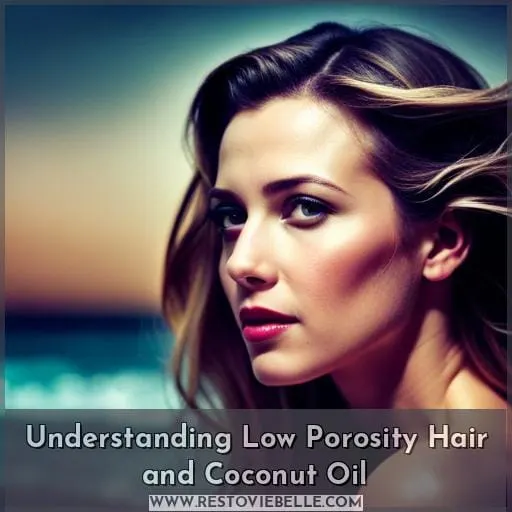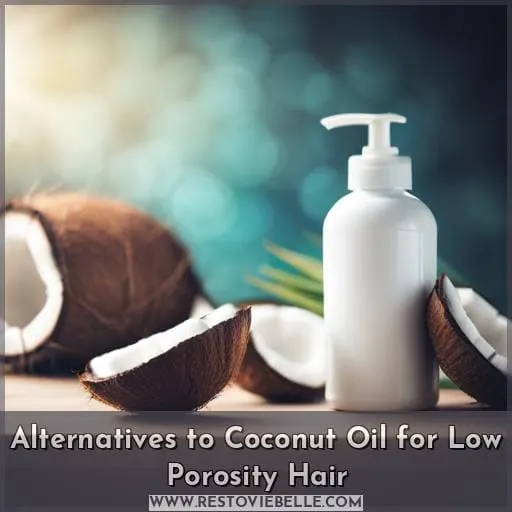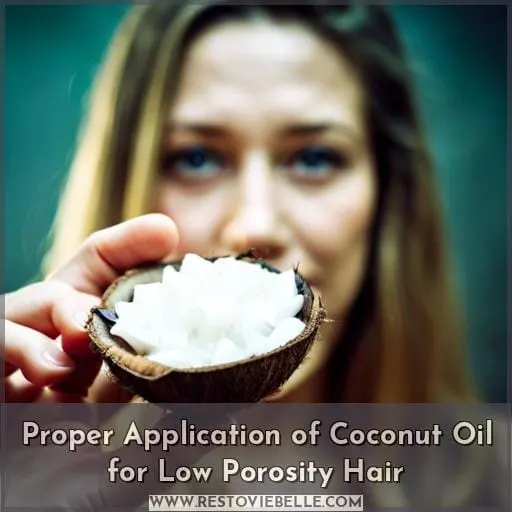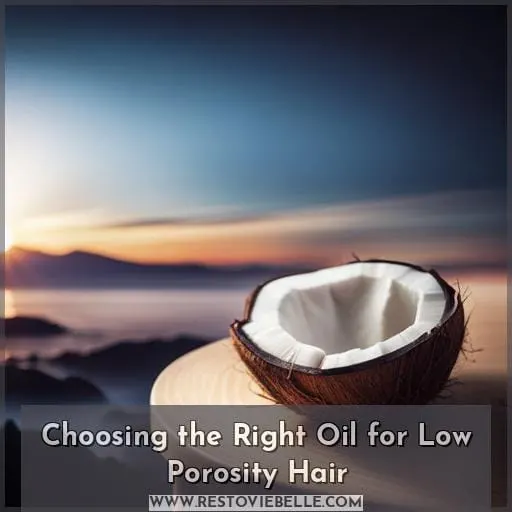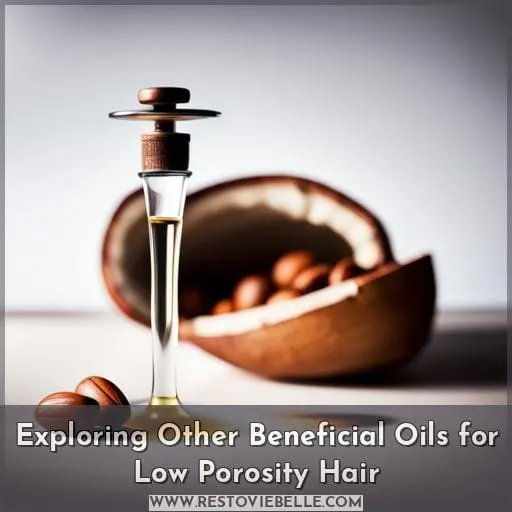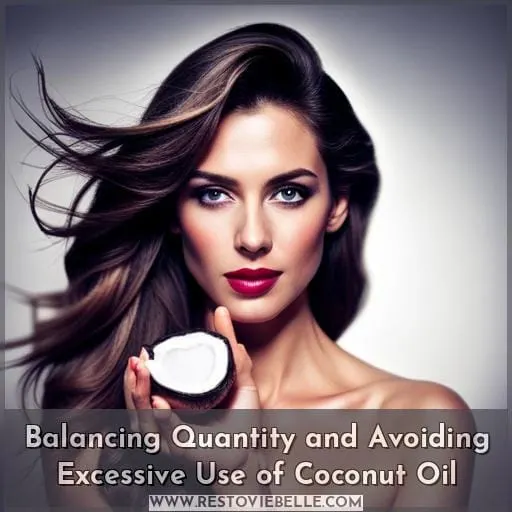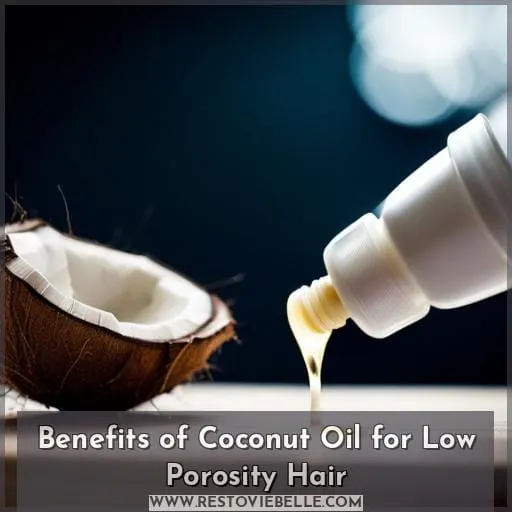This site is supported by our readers. We may earn a commission, at no cost to you, if you purchase through links.
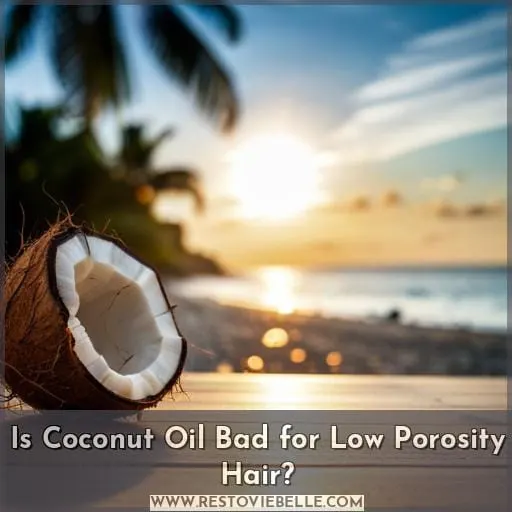 Imagine finally finding a product that could work wonders for your low porosity hair, only to discover conflicting information about whether or not it’s actually beneficial.
Imagine finally finding a product that could work wonders for your low porosity hair, only to discover conflicting information about whether or not it’s actually beneficial.
We’ll explore the properties of low porosity hair and the potential challenges coconut oil may pose. Discover alternatives, proper application techniques, and other oils that can help nourish your locks effectively.
Gain mastery over caring for your unique hair type with our research-driven insights.
Table Of Contents
- Key Takeaways
- Understanding Low Porosity Hair and Coconut Oil
- Alternatives to Coconut Oil for Low Porosity Hair
- Proper Application of Coconut Oil for Low Porosity Hair
- Choosing the Right Oil for Low Porosity Hair
- Exploring Other Beneficial Oils for Low Porosity Hair
- Experimentation and Professional Guidance for Finding the Best Oil
- Balancing Quantity and Avoiding Excessive Use of Coconut Oil
- Benefits of Coconut Oil for Low Porosity Hair
- Frequently Asked Questions (FAQs)
- Conclusion
Key Takeaways
- Coconut oil can be too heavy for low porosity hair and cause buildup.
- Low porosity hair needs moisture, not oil.
- There are many other natural oils that are better for low porosity hair, such as jojoba oil, argan oil, and olive oil.
- Coconut oil can be used on low porosity hair, but it should be applied sparingly and rinsed out thoroughly.
Understanding Low Porosity Hair and Coconut Oil
Low porosity hair, characterized by tightly packed cuticles, poses challenges for coconut oil penetration.
Due to its small molecular size, coconut oil can effectively moisturize and nourish low porosity hair by reaching deep into the hair structure.
However, it’s important to understand how to properly apply coconut oil and avoid excessive use to prevent buildup and greasiness on low porosity hair.
Properties of Low Porosity Hair
One distinctive trait of low porosity hair is its tightly packed cuticles, which make it difficult for moisture and oils to penetrate the hair shaft. The porosity traits like slow water absorption, resistance to hair dyes, and prolonged drying times pose challenges for effective conditioning.
Understanding factors like the molecular makeup facilitates finding solutions to address protein loss and enhance moisture retention in low porosity hair.
Challenges of Coconut Oil for Low Porosity Hair
Using coconut oil for low porosity hair comes with its own set of challenges due to the nature of this type of hair structure:
- Penetration Challenges: Tightly packed cuticles hinder effective absorption.
- Greasiness Concerns: Improper use or excessive amounts may result in a greasy appearance.
- Optimal Application: Properly applying smaller quantities helps prevent buildup while still providing moisture and nourishment.
Overcoming these absorption issues is crucial in order to fully reap the benefits that coconut oil offers for managing low porosity hair care needs.
Potential Negative Effects on Hair
Coconut oil can have potential negative effects on low porosity hair due to its heavy nature and limited ability to penetrate the tightly packed cuticles.
Overuse leads to product buildup, greasy look and feel, and itchy scalp.
Excessive coconut oil hinders moisture retention in the hair shaft, resulting in dryness and increased risk of breakage over time.
Moderating use and incorporating alternative lightweight oils reduces these drawbacks and supports overall hair health.
Alternatives to Coconut Oil for Low Porosity Hair
When it comes to low porosity hair, coconut oil may not be the best option for effective absorption.
Lighter oils like argan, grapeseed, and jojoba are recommended as they’ve smaller molecules that can penetrate low porosity hair more easily.
Additionally, choosing the right products specifically formulated for low porosity hair is crucial in maintaining its health and moisture balance.
Lighter Oils for Better Absorption
To improve the absorption of oils in low porosity hair, it’s important to explore alternatives that are lighter and more easily absorbed into the hair shaft.
Lightweight oils provide better oil absorption and promote effective hydration. These alternatives include grapeseed, argan, and jojoba oil.
Grapeseed oil is known for its lightweight nature and ability to support growth while providing shine.
Argan oil contains vitamins C, B, and E which help nourish the hair without weighing it down.
Jojoba oil offers deep moisturization with its rich vitamin content (C,B,E).
By incorporating these lightweight oils into your routine using proper application techniques such as sealing or adding a few drops to shampoo/conditioner can enhance moisture retention in low porosity hair while preventing breakage.
Choosing the Right Products for Low Porosity Hair
Your hair’s overall health depends on selecting the proper oils and conditioners suited for low porosity strands. It’s crucial to choose lightweight, water-based products that can sufficiently moisturize the hair shaft without leading to buildup or greasiness.
- Seek out oils that absorb well like jojoba, grapeseed, or argan rather than coconut oil.
- Opt for conditioners designed specifically for low porosity hair.
- Experiment to find ideal leave-in treatments to boost moisture.
Carefully tailoring your hair care routine with compatible products will help manage this hair type, prevent damage, and promote healthy, vibrant strands.
Proper Application of Coconut Oil for Low Porosity Hair
When using coconut oil on low porosity hair, you’ll want to:
- Apply it to damp or wet hair to aid absorption.
- Avoid putting too much to prevent residue buildup and greasiness.
- Use heat, leave it on for at least 30 minutes, or do an overnight treatment to allow the oil to better penetrate the tightly packed cuticles.
Applying Coconut Oil to Damp Hair
One can enhance the absorption of coconut oil in low porosity hair by applying it to damp or wet strands before heat styling or letting it sit.
This allows the hair cuticle to swell and open, enabling better penetration of the oil to provide moisture retention.
Using heat further aids absorption while preventing greasiness.
The coconut oil then effectively conditions hair for easier detangling.
Avoiding Over-Application
Having applied coconut oil to damp hair, avoid over-application by using only a small amount to prevent your hair from feeling heavy or greasy.
- Start with a dime-sized amount
- Add more oil gradually if needed
- Assess hair’s feel before applying more
Utilizing Heat for Enhanced Penetration
To enhance the penetration of coconut oil in low porosity hair, try utilizing heat during the application process.
Heat application acts as a thermal aid, aiding in effective absorption and moisture retention.
The warmth helps open up the cuticles, allowing the coconut oil to penetrate deeply into the hair shaft for maximum benefits without causing heat damage.
Incorporating this step into your hair care routine can improve overall conditioning and nourishment of low porosity hair strands.
Recommended Duration for Leaving Coconut Oil in Hair
After utilizing heat for enhancing coconut oil’s penetration, aim for leaving it in your hair overnight or for at least 30 minutes before washing to get the best moisturizing results.
- Overnight Benefits: Maximize absorption during sleep.
- Heat Application: Enhance penetration with a warm towel.
- Optimal Soaking Time: Ensure deep moisturization.
- Moisture Retention: Lock in hydration for improved hair health.
Choosing the Right Oil for Low Porosity Hair
When navigating the realm of oils for low porosity hair, prioritizing lightweight options is paramount for effective moisturization.
Consider the specific benefits each oil brings to the table; whether it’s the growth-promoting properties of argan oil, the scalp-cleansing attributes of tea tree oil, or the deep moisture provided by almond oil.
Equally important is avoiding oils that create barriers to moisture absorption, ensuring your chosen oil aligns with the unique needs of low porosity hair.
Lightweight Oils for Effective Moisturization
Choose the right oil for your low porosity hair by opting for lightweight alternatives that masterfully moisturize.
Grapeseed, jojoba, and argan oils stand out for their ability to nourish without overwhelming your hair. These lightweight oils ensure effective moisture absorption, addressing the challenges posed by tightly packed cuticles.
Incorporate them into your customized haircare routine, applying in moderation to prevent buildup.
These moisture-rich options unlock the secret to achieving optimal results in low porosity haircare, promoting healthier, more manageable locks.
Consideration of Specific Benefits of Different Oils
Selecting the right oil for your low porosity hair involves considering the specific benefits that different oils offer.
When evaluating options, factor in your hair’s unique needs.
Seek guidance from a hairdresser to determine your porosity level.
Opt for fractionated coconut oil with smaller molecules for improved absorption.
Conduct patch tests to ensure compatibility.
Explore oils like jojoba (rich in vitamins C, B, and E), grapeseed (lightweight, promotes growth, adds shine), and apricot kernel (antioxidants, vitamins) for tailored moisturization.
Avoiding Oils That Create Barriers to Moisture
Navigating the delicate balance of moisture retention in low porosity hair involves steering clear of oils that inadvertently create barriers to hydration.
Opt for lightweight alternatives like jojoba, grapeseed, or apricot kernel oil, which won’t impede moisture absorption. These oils support hydration without weighing down your hair, promoting a healthier haircare routine.
Consider your specific needs, ensuring product compatibility, and prioritize scalp health in your quest for optimal moisture without the hindrance of oil-induced barriers.
Exploring Other Beneficial Oils for Low Porosity Hair
If you’re navigating the complexities of low porosity hair, considering alternatives to coconut oil is crucial for effective care.
Avocado oil steps in with its richness in monounsaturated fats and antioxidants, delivering deep moisture without weighing down your strands.
Olive oil, boasting fatty acids and vitamins A and E, penetrates and moisturizes, addressing the unique needs of low porosity hair.
Almond oil, abundant in fatty acids and vitamins, excels in locking in moisture and enhancing hair elasticity, while tea tree oil, a natural antifungal, cleanses the scalp and unclogs hair follicles.
Experimentation and professional guidance become essential in finding the best oil tailored to your individual hair needs.
Avocado Oil for Deep Moisture
For deep moisturization in low porosity hair, consider incorporating avocado oil into your hair care routine.
- Intense Moisture Retention: The unique composition of fatty acids found in avocados allows them to penetrate deeply into each strand[^2^]. This allows for thorough hydration which helps prevent dryness without leaving any greasy residue behind.
- Repairing Damaged Hair: Low porosity locks often face challenges when it comes to repairing damage caused by heat styling or chemical treatments[^3^]. However, with its abundance of vitamins E & B-5 along with antioxidants such as vitamin C & E;avocado oils aid significantly repairing damaged hairs
- Enhancing Shine: When used regularly ,Avacado Oils improve sheen.,Low Porosity tends toward dullness but adding this nutrient-rich ingredient promotes healthy shine while also improving overall texture
- Improving Manageability: Dealing with low porosity hair can be a struggle, especially when it comes to styling. Avocado oil smooths the cuticles and improves overall texture for better manageability [^1^]. This makes detangling easier and reduces frizz, making your hair more manageable.
With its numerous benefits for deep moisture retention in low porosity locks, avocado oil is an excellent addition to any hair care routine. Whether you choose to use it as a pre-shampoo treatment or incorporate it into your regular styling products, avocado oil can help nourish and repair damaged strands while enhancing shine and improving manageability[^4^].
So why not give avocado oil a try? Your low porosity hair will thank you with improved health, increased moisture retention ,better texture,and enhanced shine
Olive Oil for Deep Penetration and Moisturization
To deeply penetrate and moisturize low porosity hair, olive oil is a beneficial option.
Olive oil provides deep hydration, promotes scalp health, enhances hair elasticity, and offers antioxidant benefits.
Its ability to penetrate the hair shaft effectively ensures optimal moisture retention for those with low porosity hair.
Consider incorporating olive oil into your routine for improved results compared to coconut oil.
Almond Oil for Locking in Moisture and Enhancing Elasticity
Discover how almond oil, with its rich blend of fatty acids and vitamins, becomes a go-to choice for enhancing moisture retention and boosting elasticity in low porosity hair.
Nourishing Properties: Almond oil deeply nourishes the hair shaft.
Moisture Locking: It effectively locks in moisture, combating dryness.
Enhanced Hair Flexibility: Boosts hair flexibility and resilience.
Elasticity Enhancement: Improves elasticity, reducing breakage.
Tea Tree Oil for Scalp Health and Unclogging Hair Follicles
Tea tree oil revitalizes the scalp and clears hair follicles, benefiting low porosity hair. Its natural anti-fungal properties promote scalp health, aiding in unclogging hair follicles. This oil infusion fosters scalp cleansing, rejuvenating follicles, and enhancing hair vitality, offering a different approach than coconut oil for various hair types.
Experimentation and Professional Guidance for Finding the Best Oil
When determining the ideal oil for low porosity hair, tailoring your routine to your unique needs is crucial.
Seeking professional guidance ensures a more personalized approach, optimizing your hair care regimen for the best possible results.
With a focus on individuality and expert advice, you can navigate the complexities of low porosity hair care effectively.
Tailoring Hair Care Routine to Individual Needs
Tailor your hair care routine to meet your individual needs by experimenting with various oils under professional guidance.
- Identify Your Hair’s Needs: Assess your hair’s characteristics and needs before selecting an oil. Low porosity hair requires lighter oils for better absorption.
- Consult with Professionals: Seek guidance from hair specialists or dermatologists to determine the most suitable oil for your hair type. Their expertise ensures tailored regimens for optimal results.
- Test and Evaluate: Experiment with different oils in small quantities to understand their effects on your hair. Monitor how your hair responds to each oil.
- Adjust and Refine: Based on observations, adjust the frequency and quantity of oil application. Personalized strategies ensure your hair treatment aligns with its unique requirements.
Crafting a customized coconut oil hair care routine for low porosity hair demands precision and adaptation to ensure effective results.
Seeking Professional Advice for Optimal Results
To achieve optimal results for your low porosity hair, it’s essential to seek professional guidance and experiment with different oils under their expert advice.
A trichologist or a hair care specialist can provide personalized advice and customized recommendations tailored specifically to your unique needs. They’ve the knowledge and expertise to assess your hair type, determine its porosity level, and suggest suitable alternatives to coconut oil if necessary.
By consulting a professional, you can gain valuable insights on trichologist-approved hair products and curly hair solutions that will work best for your low porosity strands.
| Professional Consultation | Expert Guidance | Customized Recommendations |
|---|---|---|
| Assess Hair Porosity | Suggest Alternatives | Recommend Suitable Oils |
Balancing Quantity and Avoiding Excessive Use of Coconut Oil
In understanding the effects of coconut oil on low porosity hair, it’s pivotal to maintain a balance to prevent buildup and greasiness while ensuring your hair doesn’t feel excessively heavy. Following recommended guidelines becomes paramount to harness the effectiveness of coconut oil without compromising hair texture.
Managing quantity and application methods play a crucial role in optimizing coconut oil’s benefits for low porosity hair without causing adverse effects like buildup or heaviness.
Preventing Buildup and Greasiness
Managing how much you apply can be crucial in preventing buildup and greasiness when using coconut oil on low porosity hair.
- Use a small amount.
- Apply less often.
- Use as a pre-shampoo hair mask.
- Mix with other oils to dilute.
Ensuring Hair Does Not Feel Heavy
Avoiding excessive coconut oil use is key to ensuring your hair doesn’t feel heavy.
Applying a small amount of coconut oil as a pre-shampoo treatment can help to moisturize and detangle hair without weighing it down.
Additionally, incorporating lightweight oils into your hair care routine can help to balance the weight of coconut oil and prevent negative effects.
Following Recommended Guidelines for Effective Use
Following the recommended guidelines for effective use of coconut oil will help you avoid buildup and greasiness.
- Applying coconut oil in small amounts
- Using coconut oil as a pre-shampoo treatment
- Inncorporating coconut oil into a balanced hair care routine
- Avoiding excessive coconut oil use
Benefits of Coconut Oil for Low Porosity Hair
Despite its reputation as a heavy oil, coconut oil can be beneficial for low porosity hair when used correctly.
It can effectively moisturize and nourish your hair, improve manageability and styling, and address the challenges posed by tightly packed cuticles.
Additionally, coconut oil can form a protective layer around your hair, promoting overall hair health.
Effective Moisturization and Nourishment
When used correctly, coconut oil can moisturize and nourish low porosity hair effectively.
Its small molecular size facilitates penetration, and proper application, a balanced hair care routine, and avoiding excessive coconut oil use can help you reap the benefits of its fatty acids, proteins, and vitamins.
Improved Manageability and Styling
Coconut oil can help to improve the manageability and styling of your low porosity hair.
It prevents breakage, reduces frizz, prevents damage, enhances shine, adds volume, and encourages hair growth.
Addressing Challenges Posed by Tightly Packed Cuticles
By addressing the challenges posed by tightly packed cuticles, you can improve the manageability and styling of your low porosity hair.
Coconut oil, with its small molecular size, has the ability to penetrate deep into the hair shaft. This deep penetration allows for effective moisturization and nourishment, promoting overall hair health.
Additionally, coconut oil forms a protective layer on each strand, enhancing manageability and ease of styling.
Protective Layer and Overall Hair Health
While coconut oil may not be the best choice for moisturizing low porosity hair, it can still provide benefits such as:
- Preventing moisture loss
- Reducing frizz
- Preventing breakage
- Softening hair
- Promoting shine
Frequently Asked Questions (FAQs)
What are the signs of low porosity hair?
Signs of low porosity hair include:
- Slow water absorption
- Resistance to dyes
- Prolonged drying time
What are the best oils for low porosity hair?
The best oils for low porosity hair are:
- Lightweight
- Liquid at room temperature
- Such as argan, jojoba, and grapeseed oil.
How do I apply coconut oil to low porosity hair?
To apply coconut oil to low porosity hair,
- Apply a small amount to damp hair
- Leave it on for at least 30 minutes or overnight.
You can also use heat, such as a hair dryer or hot towel, to enhance the penetration of the oil.
How can I avoid excessive coconut oil use?
To avoid excessive coconut oil use,
- Apply a small amount to damp hair
- Leave it in for at least 30 minutes
- Rinse thoroughly with warm water and shampoo
- Avoid using coconut oil more than once a week
What are the benefits of coconut oil for low porosity hair?
While coconut oil is often recommended for hair care, it can be too heavy for low porosity hair.
Fractionated coconut oil, with smaller molecules, is better absorbed and may offer benefits like shinier hair and improved growth.
Conclusion
While coconut oil can be beneficial for low porosity hair, it’s important to use it correctly and in moderation to avoid potential negative effects.
Experiment with different oils and application methods to find the best combination for your hair type.

